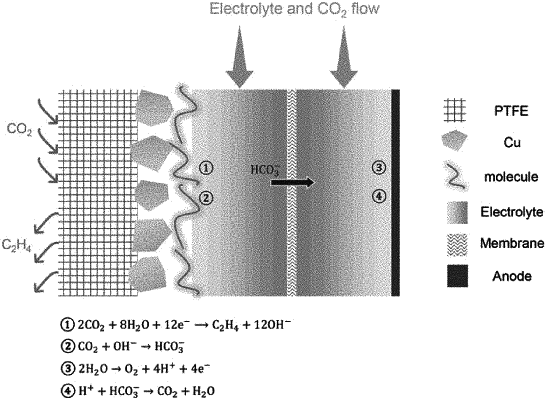| CPC C25B 3/25 (2021.01) [B01J 23/72 (2013.01); C25B 9/23 (2021.01); C25B 11/031 (2021.01); C25B 11/095 (2021.01); C25B 13/08 (2013.01); C25B 15/02 (2013.01); C25B 15/08 (2013.01)] | 32 Claims |

|
1. An electrolytic system for electrochemical reduction of carbon dioxide, the system comprising:
an anode;
a cathode in electrical communication with the anode, the cathode comprising:
a first current collector;
a porous gas-diffusion membrane having a first side and a second side; wherein the porous gas-diffusion membrane is permeable to CO2; and
an electrocatalyst layer adjacent to the second side of the gas-diffusion membrane and in electrical communication with the first current collector; the electrocatalyst layer comprising:
an electrically conductive catalyst; and
a selectivity-determining organic material attached to at least a portion of the electrically conductive catalyst; wherein:
the organic material is formed of a plurality of oligomers;
each oligomer comprises a plurality of covalently bonded base units; and
each base unit comprises at least one heterocyclic group having at least one nitrogen in its ring structure;
an anion exchange membrane adjacent to the electrocatalyst layer and positioned between the anode and the cathode; wherein anion exchange membrane is characterized by anion conductivity and the cathode is in ionic communication with the anode via the anion exchange membrane;
a catholyte in contact with the cathode and the anion exchange membrane, the catholyte comprising dissolved CO2 and HCO3− anions and/or CO32− anions; and
an anolyte in contact with the anode and the anion exchange membrane, the anolyte comprising dissolved CO2 and HCO3− anions and/or CO32− anions;
wherein CO2 is formed in the anolyte according to reaction Eq. 1 and/or reaction Eq. 2:
H++HCO3−→CO2+H2O (Eq. 1) and/or
2H++CO32−→CO2+H2O (Eq. 2); and
wherein each of the anolyte and the catholyte comprises a carbonate and/or bicarbonate electrolyte saturated with CO2.
|